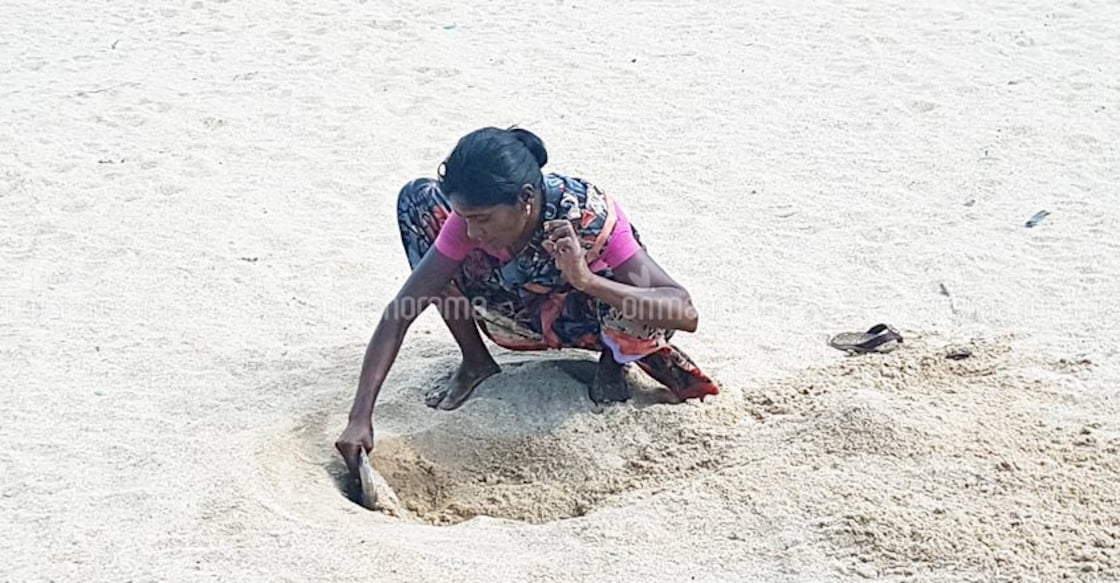Lesson for parched Chennai from a Dhanushkodi village

Mail This Article
Travellers en route Dhanushkodi from Rameshwaram are most likely to witness a rare sight. Through the gaps of the tall casuarina (kattadi) trees lining the coast of the Indian Ocean, a careful observer can see local women dig deep into the white sand with improvised metal plate shovels. Bright florescent plastic pots of different hues would cluster around their feet like coloured candies.
To a fantasist and staunch believer of magical realism, they could be treasure hunters striving to uncover the wealth lost in a deluge of the past, or women reliving their childhood, building elaborate sand castles.
But at least this time round, the reality triumphs magic. In a matter of five minutes of shovelling and scrapping, the pure white sand gives way to water. Not the salty sea water oft expected from a beach and its whereabouts, but pure water worthy of comparison to any Himalayan spring. For a common man, who believes water-bearing-rocks and trees were only mysteries quoted from the time of prophets, this can be a startling revelation.
“We use this water for drinking and cooking,” says Kavitha, a local from Parathi village located seven kilometres away from Dhanushkodi.

Nearby, other women fetch water from a small open well, paved with concrete. At one glance, it appears to be a shallow basin filled with clear water. The water from these crude but permanent well, just four or five metres into the ground, is used for bathing and cleaning purposes due to its slightly salty nature.
Further down the road, women walk with their pots and pans braving miles in the hot sun to collect water from the tankers and pipes located uptown, drawing an eerily strong similarity with their counterparts in Rajasthan.
While drying up of reservoirs and unsustainable depletion of groundwater supply in Chennai has grabbed media headlines, the situation in the rural areas of Tamil Nadu has gone largely unnoticed. A look at the lives of the people in Rameshwaram-Dhanushkodi stretch shows that their plight is miserable at best.
Dhanushkodi, a town at the southern tip of Pamban Island, has been titled a ghost town after the area was submerged during a severe cyclone in 1964. The occasional tourists notwithstanding, the area has remained free from human habitation since then.
The Parathi village houses a few who remain. “The sea took a toll on our families years ago. Many died. Others picked up what remained of their belongings and left. We are just 10 families in Parathi, now. Our husbands are fishermen. We also sell stuff made from shells,” the woman said, indicating that she and her friends had no intention of leaving the place.

The blooming tourism in the region is one of the reasons why these families stay in the region. Though not fully comprehensive of tourism and its potential, they collect sea-shells to create ornaments and sell them to the shopkeepers in Dhanushkodi for a meager amount. Sometimes, they prepare small sumptuous roadside delicacies for hungry passers-by for money.
A teacher from Rameshwaram hitch-hiked with us to reach the lone school here. She taught all the children in the school irrespective of their age or grade, says a tourist who was on his second visit to Dhanushkodi. Education is neither a routine affair nor a priority for them. Perhaps, the fact that these families live at the mercy of the sea just 50 metres away from the mighty and furious Indian Ocean makes it less of a worry to them.
Their homes are not much to speak of either. With thatched roofs and sandy floors cluttered with fishing nets, these frail structures are not sturdy enough to withstand a strong wind.
Their only solace, if any, is the ground which yields them God-send water every now and then.
A peek into Dhanushkodi's geography will reveal the reason behind this mysterious phenomenon. Dhanushkodi lagoon on Rameshwaram Island is a coastal wetland. Coastal wetlands are usually fed by surface run-offs and groundwater seepage. It is surprisingly, not affected by the salty sea water which lashes against the coast a few metres away.
The lack of significant habitation in the area is possibly the only reason why the groundwater in Dhanushkodi remains replenished even today.
In hindsight, this rare phenomenon actually shows us how bountiful our groundwater sources were once upon a time. There was a time when groundwater was enough to act as a buffer between monsoon and drought.

Interestingly, present-day Chennai reeling in the drought situation was a similar wetland in the 1980s. While the plentiful groundwater proved to be a major boost to the mushrooming growth of the metropolis, the unscientific construction of the city over the wetland with no room for seepage led the depletion of the groundwater. The lack of an effective drainage system has made the city prone to two very different types of disasters -- drought due to low replenishment of groundwater sources and flooding of low lying areas.
According to a Chennai-based biodiversity research organization, Chennai's wetlands diminished from 80 per cent in 1980s to 15 per cent in 2016. The encroachment of water bodies to accommodate the city's needs has been driving a nail in its coffin simultaneously.
The women from Dhanushkodi are not living lives of glory above a treasure trove of water. In their makeshift huts, they still press their ears close to the ground. They know a deluge is not far, even in the time of drought. They know Mother Nature has a trigger point and pushing it beyond can invite her wrath.


